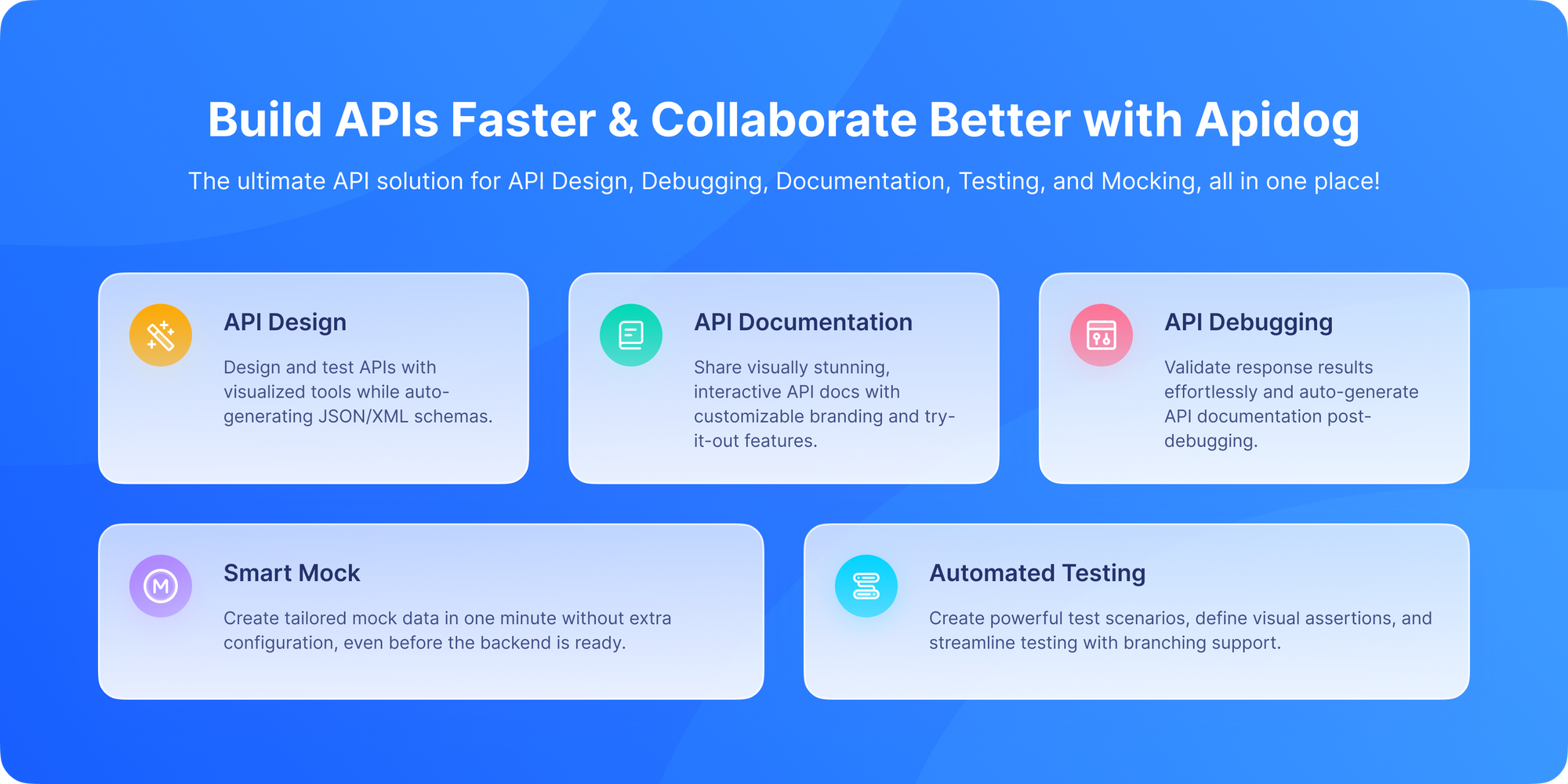If you’ve spent any time in software development—whether as a developer, team lead, or someone just exploring modern practices—you’ve probably heard of Test Driven Development (TDD). Maybe it came up in a code review, or a colleague swore it’s the only way to write clean code.
But what exactly is TDD? Why does it matter, and how can it help you write cleaner, more reliable code? And where does API testing fit into the picture?
In this post, we’ll break it down in plain English: what TDD is, how it works, its benefits and challenges, and how tools like Apidog can make testing smoother. By the end, you’ll know whether TDD is worth adding to your workflow.
Want an integrated, All-in-One platform for your Developer Team to work together with maximum productivity?
Apidog delivers all your demands, and replaces Postman at a much more affordable price!
What is Test Driven Development (TDD)?
At its core, Test Driven Development (TDD) is a software development approach where you write tests before writing the actual code. Sounds backward, right? But the idea is that by starting with the tests, you clarify the requirements upfront and make sure the code you write does what it’s supposed to.
Think of it like sketching out the rules of the game before you start playing. Instead of coding blindly and hoping things work, you write a test that says, "This function should return X when I give it Y". Then you write the minimal code needed to make that test pass.
The cycle looks like this:
- Write a test for a new function or feature. Since the functionality doesn't yet exist, this test will fail.
- Write just enough code to make that test pass.
- Refactor the code for clarity and efficiency while running tests to ensure it still works.
- Repeat.
This approach is sometimes summarized as Red-Green-Refactor:
- Red: Write a failing test.
- Green: Make the test pass.
- Refactor: Clean up the code.
The goal? Reliable, well-structured, and bug-resistant code.
The History of TDD
Test-Driven Development (TDD) isn’t a new concept. Its origins trace back to Extreme Programming (XP), a methodology introduced in the late 1990s. Kent Beck, one of XP’s pioneers, formally defined TDD as part of the movement toward agile development. Since then, TDD has grown into one of the most widely discussed—and debated—practices in the software industry.
Why Has TDD Gained Popularity?
TDD is loved by many because it brings order and discipline to development, helping teams catch bugs early and reduce costly fixes down the line.
Here’s why TDD is increasingly embraced in 2025:
- Increased code quality: Since you write tests first, your code naturally focuses on correctness.
- Better design: Writing tests before code forces thoughtful design and modular, testable functions.
- Reduced debugging time: Many errors are caught during the writing phase, so less troubleshooting later.
- Improved documentation: Tests serve as living documentation that explains what your code should do.
- Facilitates continuous integration: Automated tests enable faster and safer deployment cycles.
How Test Driven Development Works (Step by Step)
The process of TDD follows a simple loop often called Red-Green-Refactor. Let’s break it down:
- Red: Write a test for a small piece of functionality. Since the code doesn’t exist yet, the test will fail.
- Green: Write just enough code to make the test pass. Don’t over-engineer.
- Refactor: Clean up your code, making it more efficient or readable, while ensuring the test still passes.
Then, repeat the cycle. This keeps development tightly focused and test-driven.
How Does TDD Work with APIs?
In today’s API-driven world, TDD goes beyond UI and backend logic—it plays a key role in ensuring API reliability.
Here’s how:
- API contracts set expectations between providers and consumers. By writing tests first, you can confirm that endpoints behave as expected before integration.
- Tools like Apidog make this easier by letting you define API tests both visually and with code, automating verification throughout development.
- Automated API tests can be integrated into the CI/CD pipeline, helping catch issues early and preventing breaking changes in production.
Getting Started with TDD: A Step-By-Step Approach
If you’re new to TDD, here’s a simple roadmap to guide you:
Step 1: Write Your First Test
Write a unit test or API test that describes the expected behavior of a small feature. It should be specific and initially fail since the feature isn’t implemented.
Step 2: Implement Minimum Code
Write the smallest amount of code necessary to pass the test. Resist the temptation to add extra features at this stage.
Step 3: Run the Tests
Run automated tests to confirm that your new test and existing tests all pass.
Step 4: Refactor
Refactor your code to improve readability, remove duplication, and optimize performance. Tests guide you to refactor safely.
Step 5: Repeat
Continue the cycle for the next feature or functionality.
Key Principles of TDD
To really grasp TDD, here are a few guiding principles:
- Write small tests: Each test should focus on a single behavior or requirement.
- Keep tests simple: Complex tests defeat the purpose.
- Don't write production code without a failing test: This ensures all code has a purpose.
- Refactor ruthlessly: Clean code is as important as working code.
- Embrace feedback: Let tests guide your design decisions.
Common TDD Misconceptions
- "TDD slows me down." Actually, while TDD may feel slower upfront, the reduction in debugging, rework, and regressions speeds overall delivery.
- "It's only for unit tests." TDD applies equally to API, integration, and even UI tests. Tools like Apidog expand TDD to API testing effortlessly.
- "Writing tests first is hard." Like any habit, it takes practice and good tools to ease. Visual low-code API test creators help flatten the learning curve.
Benefits of TDD
Why bother with TDD at all? Here are some compelling reasons:
- Better Code Quality: Developers can make changes knowing tests will catch unintended errors. Since code must pass tests from the start, it’s usually cleaner and less buggy.
- Confidence in Changes: Refactoring or adding new features is less scary because tests ensure nothing breaks. Continuous testing avoids surprises late in development.
- Fewer Bugs in Production: Fewer bugs and faster delivery mean better user experience. Issues are caught early, not by end users.
- Improved Design: Tests push you toward writing modular, loosely coupled code.
- Documentation by Default: Tests act as living documentation of how the system, features should behave. Tests ensuring up-to-date docs.
- Team Alignment: Clear tests unify understanding of requirements and expected behavior.
Challenges of TDD
Of course, TDD isn’t all sunshine and rainbows. Some common challenges include:
- Initial Learning Curve: Developers new to TDD may struggle at first.
- Slower Start: Writing tests before code can feel like it slows you down initially.
- Not Always Practical: In fast-moving startups or with exploratory coding, TDD may feel too rigid.
- Maintenance Overhead: Tests themselves need to be maintained as requirements evolve.
TDD vs. Traditional Testing
You might be wondering: how does TDD differ from the usual way of testing?
- Traditional Testing: You write code first, then write tests afterward (if at all).
- TDD: You write the test first, then the code.
The difference might seem small, but it has a big impact. TDD forces you to think about requirements before diving into code.
Tools That Support Test-Driven Development
Adopting TDD is much easier when you have the right tools. Here are some popular ones:
- JUnit (Java): Widely used for unit testing in Java.
- pytest (Python): A simple yet powerful framework for Python.
- RSpec (Ruby): Behavior-driven development tool for Ruby.
- Jest (JavaScript): Great for frontend and backend JavaScript testing.
Tools That Make TDD Easier

Apidog deserves special mention. Apart from traditional testing frameworks like JUnit or NUnit, modern tools like Apidog focus on API testing, which is critical in today's microservices-driven world. With its low-code automation and test generation features, Apidog makes it easier to bring TDD principles into API development.
Why Apidog?
- Visual API test design for rapid coverage.
- Automated test execution aligned with API specs.
- Mock servers to enable development parallelism.
- Real-time collaboration for team efficiency.
Apidog bridges API design and testing, making TDD for APIs accessible and effective.
Real-World Examples of TDD in Action
Let's look at a quick example. Suppose you're writing a function to calculate discounts.
- Test First: Write a test that says, "If a customer buys 3 items, they get a 10% discount."
- Code: Write the simplest function that applies a 10% discount when items >= 3.
- Refactor: Clean up the code without changing functionality.
In API development, the process is similar. With Apidog, you can create API test cases before writing endpoint logic. The API has to meet the test requirements before being considered complete.
Integrating TDD with Your Development Workflow
To maximize TDD’s benefits, integrate it tightly with CI/CD pipelines, code reviews, and deployment automation. This ensures every code change is validated by tests and is safe to release.
The Future of Test-Driven Development
So, where is TDD headed? A few predictions:
- AI-Powered Testing: Tools will generate tests automatically based on requirements.
- Wider Adoption in APIs: API-first development will push TDD into backend workflows, with platforms like Apidog leading the way.
- Integration with CI/CD Pipelines: TDD will become a default part of DevOps pipelines.
- Shift to BDD (Behavior Driven Development): Teams may move beyond TDD to behavior-driven approaches that focus more on user needs.
Final Thoughts
Test-Driven Development (TDD) isn’t just a buzzword—it’s a proven approach that helps engineers create more reliable software. At its core, TDD is a mindset shift: instead of writing code first and testing later, you let tests guide the entire process.
It takes discipline and practice, but the benefits are clear:
- Higher code quality
- Fewer bugs
- Greater confidence in your work
For modern applications—especially API-driven systems—pairing TDD with a tool like Apidog can make a big difference. Apidog simplifies test-first API development, reduces boilerplate code, and speeds up the entire process.
🚀 Why wait? Download Apidog for free and start building APIs with confidence using TDD today!



